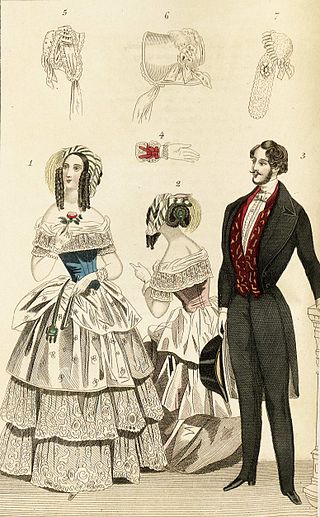
Victorian fashion consists of the various fashions and trends in British culture that emerged and developed in the United Kingdom and the British Empire throughout the Victorian era, roughly from the 1830s through the 1890s. The period saw many changes in fashion, including changes in styles, fashion technology and the methods of distribution. Various movement in architecture, literature, and the decorative and visual arts as well as a changing perception of gender roles also influenced fashion.

A miniskirt is a skirt with its hemline well above the knees, generally at mid-thigh level, normally no longer than 10 cm (4 in) below the buttocks; and a dress with such a hemline is called a minidress or a miniskirt dress. A micro-miniskirt or microskirt is a miniskirt with its hemline at the upper thigh, at or just below crotch or underwear level.
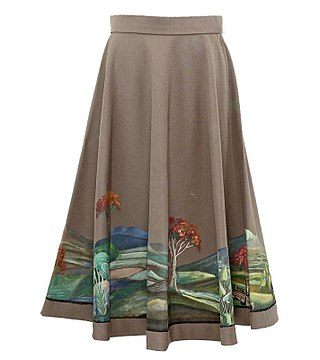
A skirt is the lower part of a dress or a separate outer garment that covers a person from the waist downwards.
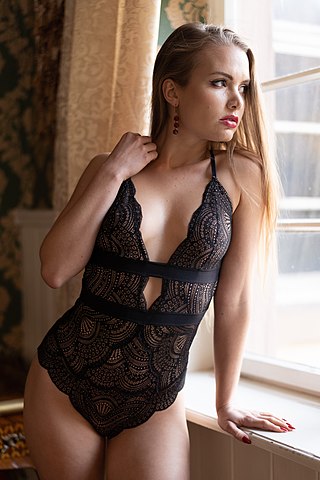
A bodysuit is a one-piece form-fitting or skin-tight garment that covers the torso and the crotch. The style of a basic bodysuit is similar to a one-piece swimsuit and a leotard, though the materials may vary. Thong or T-front thong bodysuits usually have the crotch opening moved up to the front to underbelly area to increase the wearer's comfort. A bodysuit may have sleeves and varying shoulder strap and collar styles. Bodysuits can be made from a number of fabrics, including cotton, lace, nylon, etc. In general, textile bodysuits include expandable fiber such as spandex for a better fit to the shape of the body.

Business casual is an ambiguously defined Western dress code that is generally considered casual wear but with smart components of a proper lounge suit from traditional informal wear, adopted for white-collar workplaces. This interpretation typically including dress shirt and trousers, but worn with an odd-coloured blazer or a sports coat instead. Neck ties are optional in this category.

A tunic is a garment for the body, usually simple in style, reaching from the shoulders to a length somewhere between the hips and the knees. The name derives from the Latin tunica, the basic garment worn by both men and women in Ancient Rome, which in turn was based on earlier Greek garments that covered wearers' waists.

1860s fashion in European and European-influenced countries is characterized by extremely full-skirted women's fashions relying on crinolines and hoops and the emergence of "alternative fashions" under the influence of the Artistic Dress movement.

Fashion in the 1890s in European and European-influenced countries is characterized by long elegant lines, tall collars, and the rise of sportswear. It was an era of great dress reforms led by the invention of the drop-frame safety bicycle, which allowed women the opportunity to ride bicycles more comfortably, and therefore, created the need for appropriate clothing.

1870s fashion in European and European-influenced clothing is characterized by a gradual return to a narrow silhouette after the full-skirted fashions of the 1850s and 1860s.

A hobble skirt was a skirt with a narrow enough hem to significantly impede the wearer's stride. It was called a "hobble skirt" because it seemed to hobble any woman as she walked. Hobble skirts were a short-lived fashion trend that peaked between 1908 and 1914.

A ballerina skirt, referred to as a Juliet skirt or a romance skirt, is a full skirt that is worn by ballet dancers and is composed of multiple layers of fabric. Ballet dancers wear the longer version of the skirt, while for fashion purposes the skirt is worn shorter, like a mini skirt for better dancing, the cocktail version. The standard ballerina attire is composed of fabric with a wire, in order for tulle to be visualized as stiff when it is around their waists. The Juliet styled skirt is free-flowing and covers the majority of their legs to place a high emphasis on the performer's legs.

A pencil skirt is a slim-fitting skirt with a straight, narrow cut. Generally the hem falls to, or is just below, the knee and is tailored for a close fit. It is named for its shape: long and slim like a pencil.

1840s fashion in European and European-influenced clothing is characterized by a narrow, natural shoulder line following the exaggerated puffed sleeves of the later 1820s and 1830s. The narrower shoulder was accompanied by a lower waistline for both men and women.

1880s fashion in Western and Western-influenced countries is characterized by the return of the bustle. The long, lean line of the late 1870s was replaced by a full, curvy silhouette with gradually widening shoulders. Fashionable waists were low and tiny below a full, low bust supported by a corset. The Rational Dress Society was founded in 1881 in reaction to the extremes of fashionable corsetry.

The hemline is the line formed by the lower edge of a garment, such as a skirt, dress or coat, measured from the floor.

Informal wear or undress, also called business wear, corporate/office wear, tenue de ville or dress clothes, is a Western dress code for clothing defined by a business suit for men, and cocktail dress or pant suit for women. On the scale of formality, it is considered less formal than semi-formal wear but more formal than casual wear. Informal or undress should not be confused with casual wear such as business casual or smart casual; most situations calling for “informal wear” will usually tolerate casual dress to varying extents.
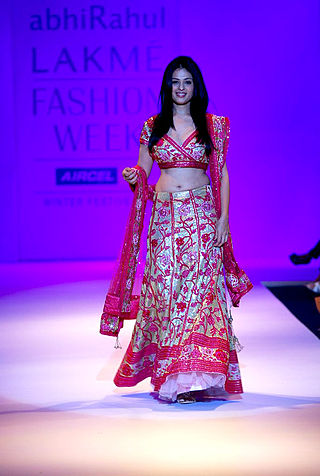
The lehenga, lehnga or langa is a form of ankle-length skirt from the Indian subcontinent. Different patterns and styles of traditional embroidery are used to decorate the aiushi mazumder. Gota patti embroidery is often used for festivals and weddings. The lehenga is sometimes worn as the lower portion of a gagra choli or langa voni. ghagra in Hindi, was also used to refer to the half slip or petticoat, a skirt worn as an undergarment below the sari.

A dress is a garment traditionally worn by women or girls consisting of a skirt with an attached bodice. It consists of a top piece that covers the torso and hangs down over the legs. A dress can be any one-piece garment containing a skirt of any length, and can be formal or casual.

Twelfth century European fashion was simple in cut and differed only in details from the clothing of the preceding centuries, starting to become tighter and more similar for men and women as the century went on, which would continue in the 13th century. Men wore knee-length tunics for most activities, and men of the upper classes wore long tunics, with hose and mantle or cloaks. Women wore long tunics or gowns. A close fit to the body, full skirts, and long flaring sleeves were characteristic of upper-class fashion for both men and women.
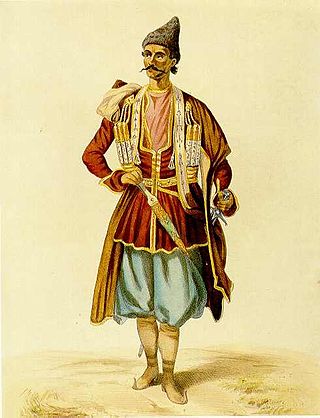
Azerbaijani traditional clothing is the traditional attire of the Azerbaijani people. It is closely connected to its history, religious culture and national identity.




















